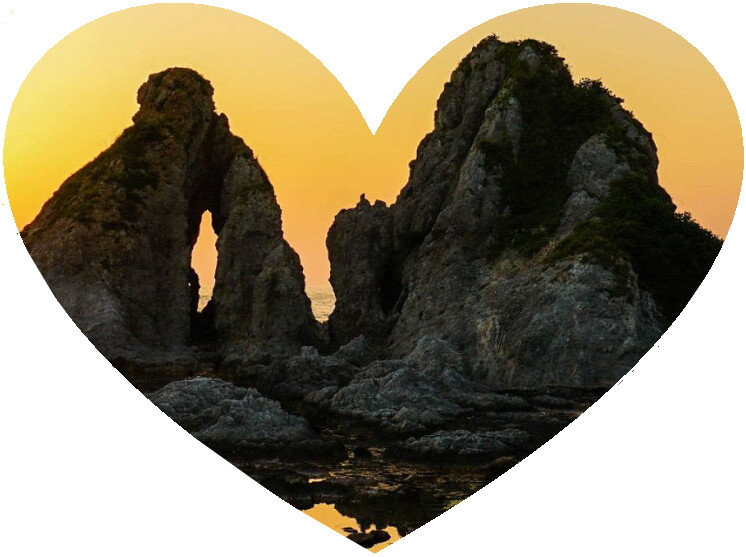Omusubi Gokko
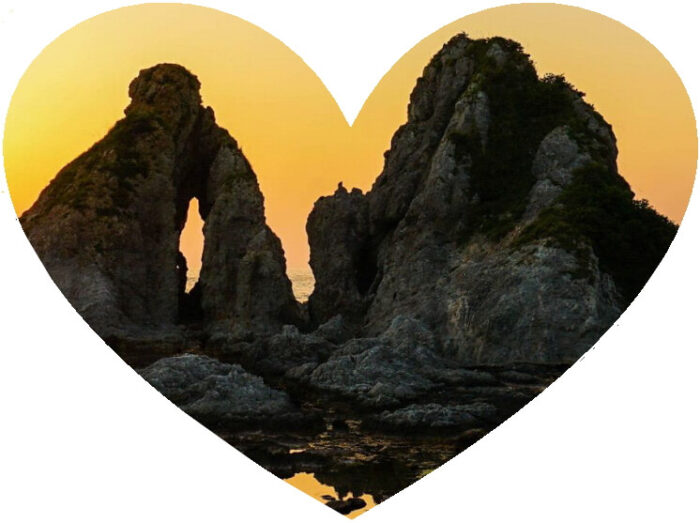 It was truly fate.
It was truly fate.
Two exceptional things met, crossed, and were born on Sado Island.
This is the story of rice ball made with Sado salt and Sado rice.
Omusubi Gokko Reservation Form
What is Sado Salt?
The history of salt production on Sado Island dates back a long time, especially from the late Nara Period to the mid-Heian Period, when it flourished and evolved into the unique Sado style of salt making earthenware.
In the first month of the 21st year of Enryaku (802) of the “nihonkiryaku”, it is written, “One hundred and twenty stones of salt from Sado Province are sent to Okati Castle in Dewa Province every year” The remains of salt manufacturing sites, some as large as 5 meters in diameter, have been found in the vicinity of the Meoto-iwa.
Following such traditional methods, Sado salt is made by burning wood, reading flames, listening to the wind, and concentrating the blessings of the Sea of Japan.It is made at the adjacent workshop “Sado-kaza-shio-gama”.

Its characteristic feature is a sweet taste. The sea of Sado island is where cold and warm currents meet. Salt made in the workshop is handmade by collecting seawater from the area near the Meoto Iwa rocks and boiling it down for about 15 hours. We also collect turban shells and abalone on these shores.
The secret to the sweetness is the skill of the artisan who slowly cooks and extracts the minerals of seawater, which the turban shells love, over a wood fire.
What is Sado rice?
This rice is grown in accordance with the certification system and “Agricultural Methods that Nurture Living Things” started in Sado City in 2007.
*Agricultural Methods that Nurture Living Things
In rice farming, it is essential to drain water from the fields in summer and allow the soil to dry until it cracks. It is also said that it is better to drain water after harvesting rice for better soil preparation and efficiency for the next season.
However, in Sado, even after harvesting, the fields are still watered, and water-filled areas are allowed to remain. In doing so, farmers work to conserve the biodiversity of the fields by securing habitats for a variety of living creatures, including the Japanese crested ibis.
In other words, the rice is friendly not only to the creatures growing in the rice paddies, but also to people.
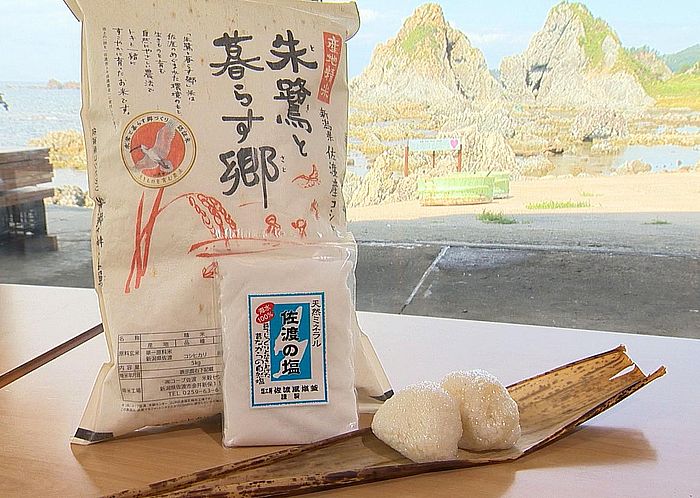
It is characterized by its springiness and stickiness, and the more you chew, the more sweetness spreads.
It’s delicious freshly cooked, but it’s also delicious cold.(It tastes better when it’s cold.)
In other words, it is the perfect rice for rice balls (omusubi)!
Experience Details
Omusubi Gokko acceptance calendar
| S | M | T | W | T | F | S |
|---|---|---|---|---|---|---|
1 | 2 | 3 | 4 | 5 | ||
6 | 7 | 8 | 9 | 10 | 11 | 12 |
13 | 14 | 15 | 16 | 17 | 18 | 19 |
20 | 21 | 22 | 23 | 24 | 25 | 26 |
27 | 28 | 29 | 30 | 31 |
| Possible | Unavailable | Unable to select time |
Reservation and Experience Flow
- 3 days agoReservationsReservation deadline is 5:00 p.m. 3 days prior to the experience date.
Email is recommended for reservations.
Omusubi Gokko Reservation Form - On the day Step1What to wear for the experienceSoot may adhere to the salt factory during the tour and work experience. Please be careful not to burn yourself.
- On the day Step2What to bringSmartphones are convenient to have.
It is an indispensable item for hearing-impaired people and foreign visitors to Japan who are not proficient in Japanese.
You can confirm in writing what you will experience. Our staff who will guide you will also use it as a cheat sheet. - On the day Step3reception(desk)Reception is possible from 60 minutes before the reservation time.
Please allow plenty of time for your visit. Please inform the store staff of your visit when you arrive. - On the day Step4PaymentPlease pay the experience fee at the reception desk. Various coupons are also available.
(Please contact the staff for details)
You can also use QR code payment (PayPay only) and various credit cards for payment.
(VISA、MasterCard、JCB、AMEX、Diners、DISCOVER、銀嶺) - On the day Step5explanationWe will inform you of the QR code of the experience-only website that has undergone multilingual processing so that you can understand and check the contents of the experience in text and the password for WiFi connection.
You will be asked to download a dedicated page for the experience on your smartphone or other device.
(Download is not required) - On the day Step6Go to the experience areaWe will guide you to the venue when all the participants are ready.
- On the day Step7Cook the Rice
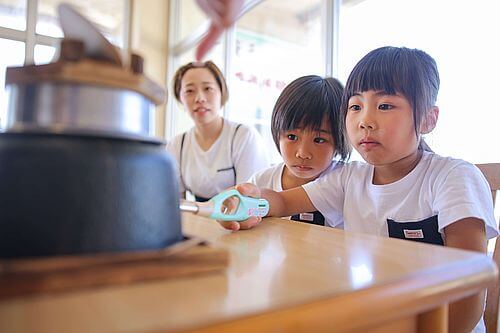 Ignite the pot for one person and start to cook the special brand Sado Rice
Ignite the pot for one person and start to cook the special brand Sado Rice - On the day Step8Prepare Bamboo Peels for Wrapping
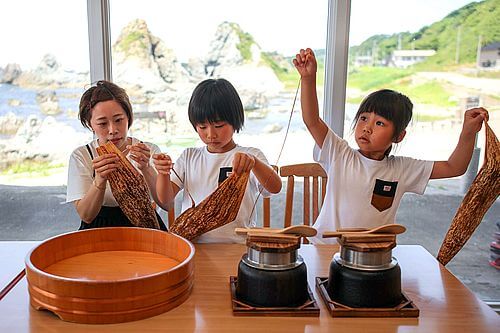
We have bamboo peels about 60cm long and 12cm wide for wrapping our omusubi.
Tear off about 5mm of both ends of the bamboo bark to make two long, thin pieces of string.
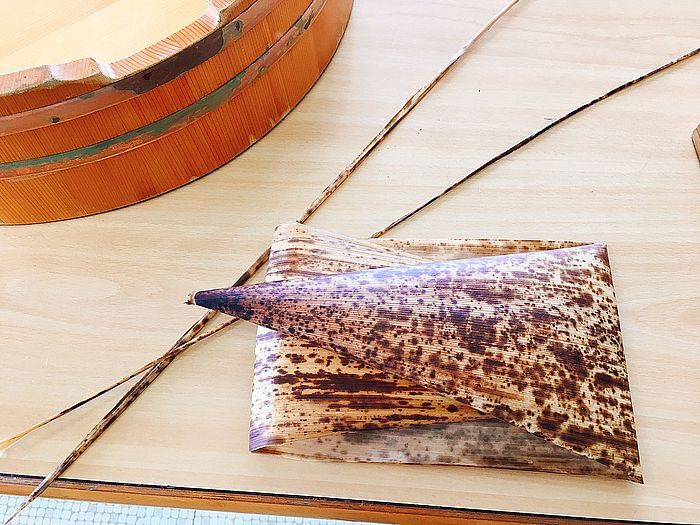
Fold the wide bamboo peels in three and set aside.
- On the day Step9Let’s make some Salt in our Salt Factory!
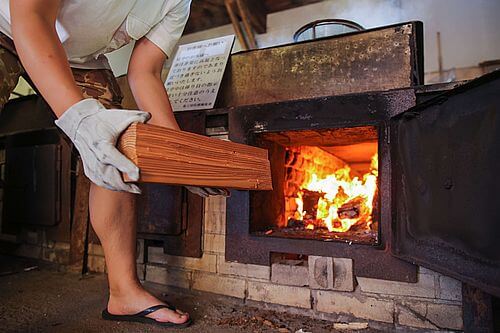
We have 30 minutes until the rice is done cookng! Use the time to go to the salt factory and get an item specially made for onigiri called “anyshio.” The sea of Sado island is where cold and warm currents meet. Salt made in the factory is handmade by collecting seawater from the area near the Meoto Iwa rocks and boiling it down for about 15 hours. We also collect turban shells and abalone on these shores.
It takes a lot of time and effort to make the salt, so the salt workshop workers will not give it to you easily. Please help the salt workers to get “Anyshio”.(Two people can get one bag of Anyshio.)
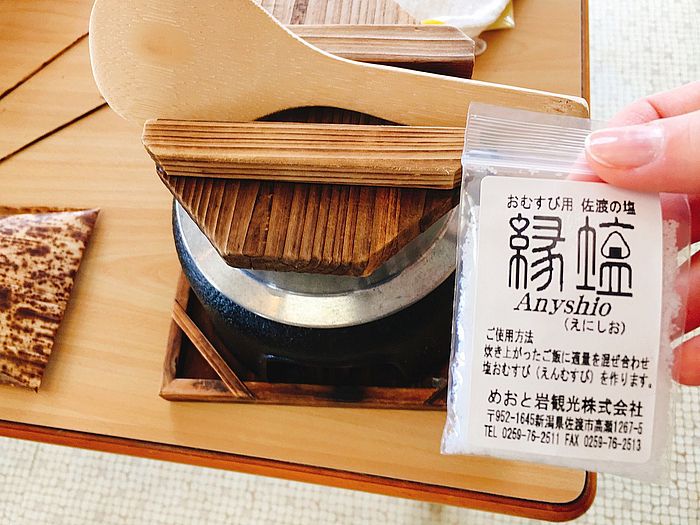
*The salt workshop be depending on the weather, you may not be able to fetch seawater or chop wood.
- On the day Step10Making Shio Musubi (Salt Rice balls)
Use the plastic gloves. Wear inflammable gloves over top of the plastic gloves Open the lid to your rice Enjoy the freshly-cooked aromas.
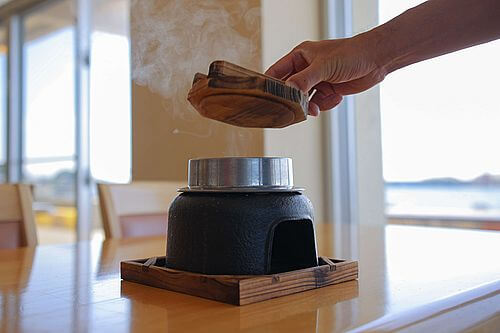
Transfer the rice from your pot into the tarai.
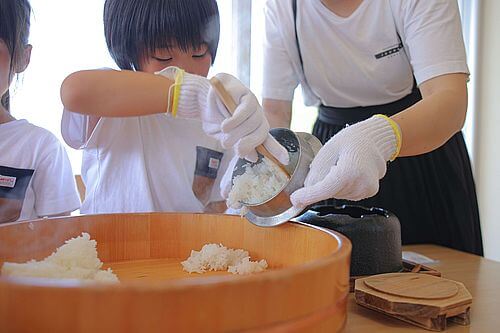
Take off the inflammable gloves and mix the “anyshio” special salt you got from the salt factory into the cooked rice. Usually salt for making onigiri is added only to coat the surface of the rice ball, but this anyshio tastes much better when mixed in!
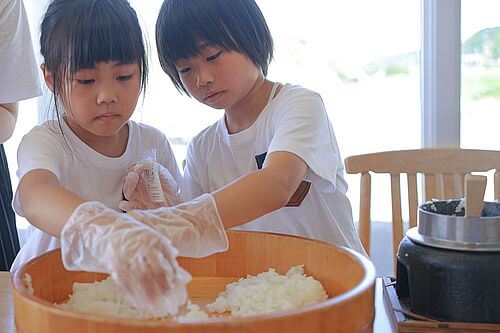
*Taste the rice and adjust the amount of salt accordingly. The saltiness of the rice will decrease as it cools down, so a slightly stronger taste is recommended.
Separate the rice into two portions. We each get to make two rice balls.
Place a piece of plastic wrap over a rice bowl, put in enough rice for one ball, wrap in plastic wrap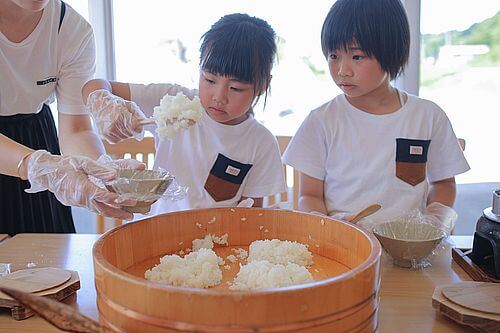
- On the day Step11Wrapping
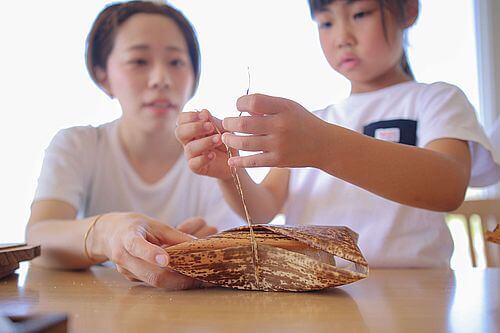 We are going to wrap our onigiri the way they did in the olden days. Spread out your folded bamboo strips and wrap the two onigiri up.
We are going to wrap our onigiri the way they did in the olden days. Spread out your folded bamboo strips and wrap the two onigiri up.
2. Using a piece of bamboo bark string, tie it into a boy knot so that it faces vertically. Your wrapping is complete!
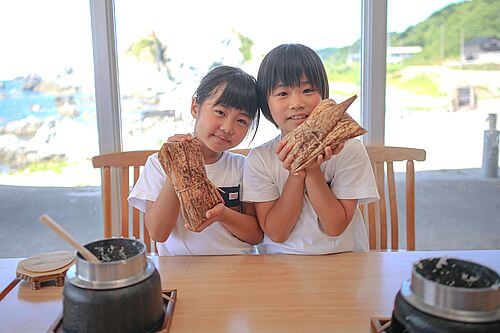
Sado Koshihikari rice tastes best after it has cooled down. Enjoy it outdoors with a nice view!
(Please consume as soon as possible.) - On the day Step12Knotting strengthen the bond
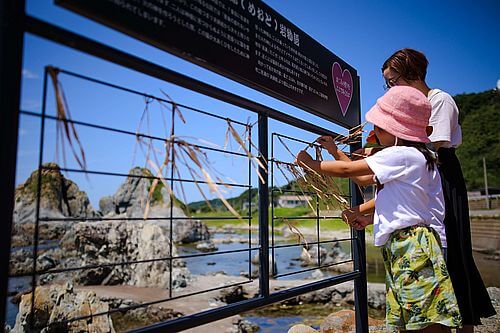
Tie one of the remaining bamboo bark strings to the frame at the outdoor enmusubi-basho (match-making) site, while thinking of the match you wish to make.
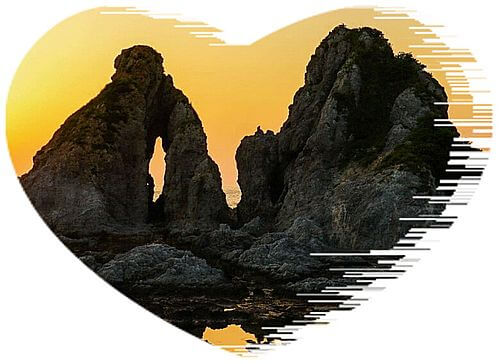 As the folklore goes, it is said that when the bamboo cord is naturally untied by the power of the rocks, your dreams of an ideal mate will be fulfilled!
As the folklore goes, it is said that when the bamboo cord is naturally untied by the power of the rocks, your dreams of an ideal mate will be fulfilled!Finally, we will help you take some photos with your smartphone, camera or other device of the Meoto Iwa rocks in the background. This concludes the program.
Omusubi Gokko Reservation Form
Strengthen the bond souvenirs
form a lucky bond souvenirs
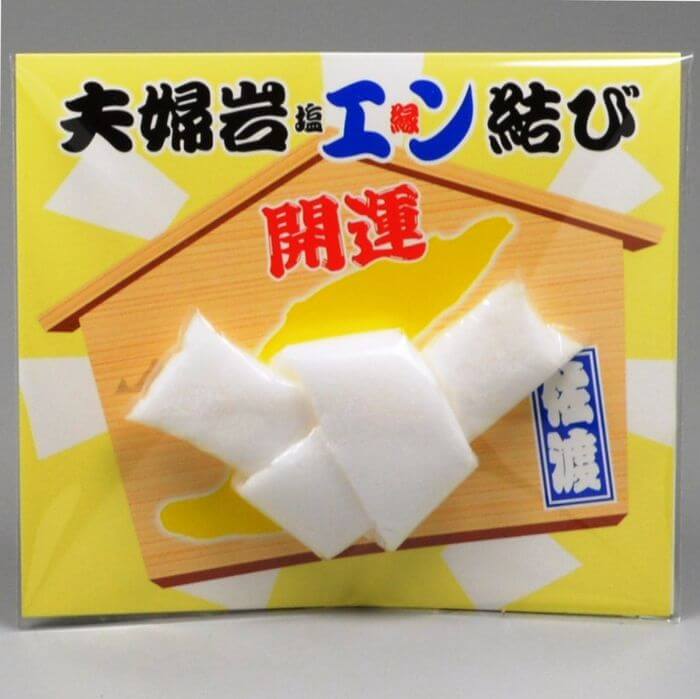
Please understand the usage and dosage and use it correctly.
【Preservation method】
Place in a conspicuous place at room temperature. A place such as a altar is best.
【how to use】
Making and eating salt rice balls while thinking of the strengthen the bond.
(Especially good if the rice is Koshihikari from Sado Island)
【expiry date】
Until the desired bond is achieved.
【Precautions for use】
Do not use it for illicit wishes.
The Meoto-iwa rocks on Sado Island are said to have originated in the myth of the birth of the nation in the Kojiki, and are revered as the god of marriage and safe childbirth.
In addition, salt production has been practiced on the coast around the Meoto-iwa rocks since ancient times, especially from the late Nara Period to the mid-Heian Period, when it flourished and evolved into the unique Sado-shiki salt-making earthenware.
Following the ancient salt-making method, Sado salt made from the Meoto-iwa Rocks of the made into sticks and tied together.
The Legend of Meoto-iwa
The story goes back to the mythical world of island creation described in the Kojiki.
Izanagi no Mikoto and Izanami no Mikoto gave birth to 14 islands and 35 gods, including Awaji Island, Shikoku, Oki Island, Kyushu, Ibishima, Tsushima, Sadogashima, and Honshu.
When the wife finished giving birth to the seventh island, he felt sorry for her exhausted appearance and took hair and saliva from her, mixed them with his own blood, and created their alter egos and a cat (a married couple and a cat rock). The cat was to serve as a guard for the gods, and the rest of the islands and the gods were to be born from the alter.
However, one day, when the alter “husband and wife rocks” were about to give birth to Hinoyagihayao no kami, the cat on guard yawned loudly due to boredom. The yawn reached Takamagahara, and the alter was discovered by the heavenly deities. The angry gods first turned the cat that was guarding the gods into a rock, and then turned the boat in which Izanagi and Izanami were riding into a rock. Hinoyagihayawo-no-kami, horrified by this, emitted light and heat like a hare and returned to the shade of Izanami-no-mikoto, where she was born again from within Izanami-no-mikoto’s body, thus restoring her physical appearance. Unfortunately, the heat emitted by Hinoyagihayawo-no-Kami caused the alter to turn reddish brown and sores, and Izanaminomikoto’s vagina was no exception.
The name of the place where the rocks are located is written “Takase” and reads “Takose,” which means the height of Takamagahara, and this place is said to be the link to Takamagahara, or the location of a brink (path) leading to Takamagahara.
The octopus is also called the ninja of the sea, and it is said that the octopus can change its body shape and color at will, and that it was a place where the scenery could be changed just like an octopus.
What was the reason for this change of scenery? According to legend, it was so that the heavenly deities of Takamagahara would not find them.
The rocks are dotted with various colors, and only the cracks around the female rock are reddish-brown. The mythological world becomes more realistic.
The Hamahata Cave site, a Yayoi period site, is located near the two large rocks, and shells and bones from that period have been excavated from the holes in the two large rocks. Perhaps the ancient people also noticed the footprints of the gods and chose this site.
Since some time ago, the two large rocks have been worshipped as gods of marriage and safe childbirth, and have come to be known as “husband and wife rocks.
What is the Japanese concept of 縁
The Japanese concept of “en” (縁) is a complex and multi-faceted idea that refers to the connections between people and things in the world. It is often translated into English as “fate”, “destiny”, “relationship”, or “bond”. En encompasses the idea that all things in the universe are interconnected, and that our lives are shaped by the relationships we form with others.
En is often associated with the idea of “enmusubi” (縁結び), which refers to the act of matchmaking or bringing two people together in a meaningful relationship. This can include romantic relationships, but it can also refer to friendships, business partnerships, or any other type of connection that has the potential to enrich our lives.
In Japanese culture, en is highly valued and is often seen as a guiding force in people’s lives. It is believed that our encounters with others are not mere coincidence, but rather the result of a deeper, more profound connection that exists between all things. As such, people often seek to cultivate en by being kind to others, maintaining strong relationships, and being open to new experiences and opportunities that may come their way.
*”En-musubi” is a Japanese word that has two different meanings. The first meaning is “salted rice ball,” which is a popular fast food in Japan. The second meaning is “the act of matchmaking or bringing people together,” which is often associated with the Shinto god of marriage. In Japanese, the word for salt is pronounced “en” and the word for edge or border is also pronounced “en,” so the word “En-musubi” can also be interpreted as “the tying of edges” or “bringing people together.”
En-musubi / Meoto-iwa

